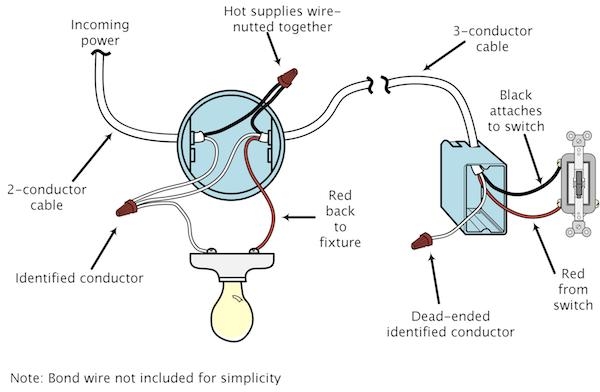
Features
Code File
Codes & Standards
Requirements for installing identified conductors for lighting switches • Code File, February 2019
February 13, 2019 | By Tatjana Dinic
 Diagram courtesy Tatjana Dinic
Diagram courtesy Tatjana DinicFebruary 13, 2019 – Section 4 in the CE Code discusses the selection of conductors and their ampacities. In 2018, the scope of this section’s Rule 4-000 was revised to clarify its intent. At the same time, since Section 12 covers conductor installation, some rules were relocated from Section 4 to Section 12 and vice-versa, for the sake of consistency and to support the revised scope of Section 4.
The major change in Section 4 is the new requirement, under Rule 4-022 2), for the installation of an identified (neutral) conductor at each location of a manual or automatic control device for the control of permanently installed luminaires at a branch circuit outlet (see diagram). Such control devices can include general-use switches, motion sensors, photocells, light dimmers or components of an energy or lighting management system.
The provision for a neutral conductor is to complete a circuit path for electronic lighting control devices. For many electronic devices, you must provide a standby power supply at the switch. When a neutral conductor is not installed, the bonding conductor may be used to fulfil its function.
While the current from an electronic control is typically very low (0.5 mA), the installation of many control devices throughout a building can result in an accumulation of excess current on the bonding conductors. Under normal operation, based on CE Code Rule 10-500, there should be no objectionable current flow in a bonding conductor.
Although Rule 4-030 2) permits a neutral conductor to be used in switch loops and not be identified, the requirements of Rule 4-022 2) take precedence, i.e. there shall be an identified conductor at each outlet box for a lighting control device.
In Ontario, if the wiring method to a lighting control switch is a raceway, then the identified conductor can be omitted if (a) the installed lighting control switch does not require it and (b) the installation not in a dwelling unit. This is similar to the exemptions of the National Electrical Code (NEC).
For three- or four-way switch installations, electrical contractors should be aware the most typical installation methods of the past are in contradiction with new Rule 4-022 2) requirements. The neutral conductors are used as ‘messengers’ and there is no unused identified conductor in each switch box.
Tatjana Dinic, P.Eng., is the code engineer at Ontario’s Electrical Safety Authority (ESA), with responsibility for code development and interpretation and for improving harmonization between codes and standards. She is a Professional Engineer with an M. Eng. degree from the University of Toronto (U of T) and a member of CSA CE Code-Part I, Sections 4, 10 and 30. She can be reached at tatjana.dinic@electricalsafety.on.ca.
This column originally appeared in the February 2019 issue of Electrical Business magazine.
Please note, this article has been corrected since it has been printed. Please click here for the correction bulletin.
Print this page